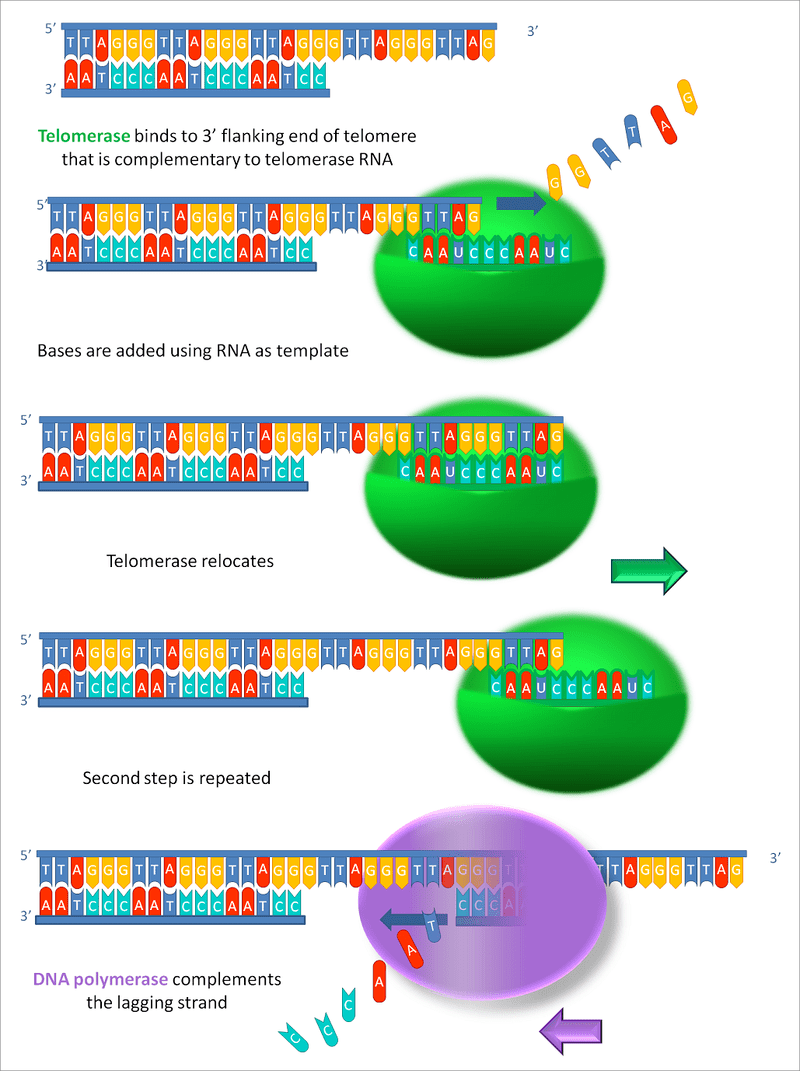Difference Between Telomeres and Telomerase
Table of Contents
Key Difference – Telomeres vs Telomerase
Genetic information is passed from parents to offspring via packaging to chromosomes. Chromosomes are thread-like structures made from DNA molecules and proteins. Chromosomes possess genetic information in the form of genes. During mitosis and meiosis, genetic information flows into daughter cells. The successful flow of information to daughter cells is done by the special regions of the chromosomes. These regions are located at the ends of the chromosome arms, and they are known as telomeres. Telomeres are protective caps of the chromosomes whereas Telomerase is an enzyme that controls telomeres. This is the key difference between Telomerese and Telomerase.
CONTENTS
1. Overview and Key Difference
2. What are Telomeres
3. What is Telomerase
4. Similarities Between Telomeres and Telomerase
5. Side by Side Comparison – Telomeres vs Telomerase in Tabular Form
6. Summary
What are Telomeres?
Telomeres are the extreme ends of eukaryotic chromosomes. Telomeres are composed of repeating DNA sequences and multiple protein components. Telomeres can contain hundreds or thousands of same repeating sequence. They act as protective caps of the chromosome ends. Telomeres prevent loss of base pair sequences from the chromosome ends by the enzymatic degradation.
Telomeres also prevent chromosomes fusing to each other and maintain the stability of the chromosomes. DNA at very ends of the chromosomes cannot be fully copied in each time of replication. It can cause for shortening of the chromosomes. However, telomere arrangement at tips of the chromosomes facilitates the complete replication of linear DNA. Proteins associated with the telomere ends also help protect them and prevent them from triggering DNA repair pathways.

Figure 01: Telomeres
The nucleotide sequence of the telomere region differs among the species. It is consists of noncoding tandemly repeated sequences. Length of the telomeres also varies among the different species, among the different cells, among the different chromosomes and according to the age of the cells. In humans and other vertebrates, commonly found repeating sequence unit in the telomeres is TTAGGG.
What is Telomerase?
Telomerase also known as telomere terminal transferase is an enzyme that catalyzes the extension of telomeres of chromosomes. The action of telomeres is also controlled by this enzyme. Telomerase is composed of protein and RNA subunits. It is a ribonucleoprotein. The RNA molecule carries by the telomerase enzyme that acts as a template to elongate telomeres by adding TTAGGG sequences to the existing chromosome ends.
Telomerase adds species-specific repeating sequences to the telomeres. When the overhanging sequences are long enough, normal DNA replication machinery produces a complementary DNA (cDNA) sequence using RNA as a template to produce double-stranded ends. Telomerase is RNA dependent DNA polymerase enzyme that uses an RNA template to make DNA for the addition. When telomeres are extended by telomerase, DNA damages are prevented.

Figure 02: Telomerase Action
Telomerase is not active in most somatic cells. In germ cells and some adult cells, active telomerase is found. Telomerases are also found in cancer cells since many cancer cells contain chromosomes that have shortened telomeres. Hence, during the cancer therapy, it is necessary to inhibit the telomerase action as well to stop the excessive proliferation of the cancer cells.
What are the Similarities Between Telomeres and Telomerase?
- Telomeres and telomerase are important in maintaining the chromosomal stability and integrity.
- Telomeres are telomerase contain nucleotides and proteins.
- Both telomeres and telomerase are important in the transmission of genetic information correctly to the daughter cells during cell division.
What is the Difference Between Telomeres and Telomerase?
Telomeres vs Telomerase | |
| Telomeres are the repetitive regions at the very ends of eukaryotic chromosomes. | Telomerase is an enzyme or a ribonucleoprotein that controls telomeres. |
| Function | |
| Telomeres special structures that provide protection from enzymatic end-degradation and maintain chromosome stability. | Telomerase catalyzes the addition of repeating units to the telomeres. |
| Composition | |
| Telomeres are mainly nucleic acids, and proteins as well. | Telomerase is an enzyme composed of amino acids, and RNA subunits as well. |
Summary – Telomeres vs Telomerase
Specialized DNA caps that are present at the tips of chromosomes are known as telomeres. Telomeres are composed of species-specific repetitive DNA and proteins. They protect chromosome ends by enzymatic degradation and maintain the stability of the chromosomes. Moreover, the presence of telomeres prevents the fusion of chromosomes with each other. The length of the telomere can be hundreds to thousands of base pairs. Length of the telomere varies among the different cell types and the age of the cell. Telomerase is the enzyme which controls telomeres. The telomeres are extended by the enzyme telomerase. Telomerase adds repeating sequences to the telomeres and extends and maintain telomere regions. Telomerase is composed of proteins and RNA units. Telomerase uses its RNA subunits as a template for synthesizing and adding repeating units to the chromosome ends. This is the difference between telomeres and telomerase.
Download the PDF of Telomeres vs Telomerase
You can download the PDF version of this article and use it for offline purposes as per citation note. Please download the PDF version here: Difference Between Telomeres and Telomerase
Reference:
1.“Telomerase.” Wikipedia, Wikimedia Foundation, 4 Feb. 2018. Available here
2.Blasco, María A., et al. “Telomeres and telomerase.” Genes & Development, Cold Spring Harbor Lab, 1 Jan. 1999, genesdev.cshlp.org/content/13/18/2353.full
Image Courtesy:
1.’Telomere’ (CC BY-SA 3.0) via Commons Wikimedia
2.’Working principle of telomerase’ By Uzbas, F, (CC BY-SA 3.0) via Commons Wikimedia
ncG1vNJzZmivp6x7pbXFn5yrnZ6YsqOx07CcnqZemLyue8OinZ%2Bdopq7pLGMm5ytr5Wau27AxKWmpp2imsBurc2dZK%2BrXamyrbvMnqmaq5Vk